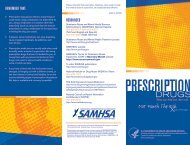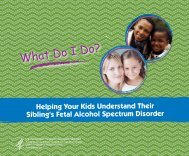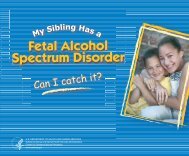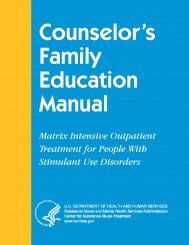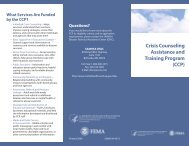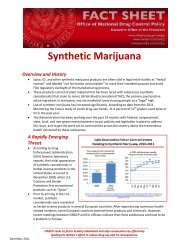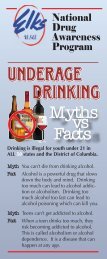There are many models <strong>for</strong> the stages of group development. The following is a composite ofseveral models:Stage 1—PreaffiliationStage 2—Power and controlStage 3—IntimacyStage 4—DifferentiationStage 5—Separation.In the preaffiliation stage, members feel uncom<strong>for</strong>table, anxious, or fearful with the newness ofthe experience. In this stage, members look to the leader <strong>for</strong> direction. Initially, the group shouldbe leader-focused, with the leader helping members adjust to the new experience.Once group members are more com<strong>for</strong>table, it is predictable that they will challenge theauthority of the leader and will pursue power and control. It is important <strong>for</strong> the leader toremember that this is a normal style in the group's development, not unlike the challenges thatface the parents of an adolescent. This phase may be uncom<strong>for</strong>table, with group membersexpressing anger and frustration. The leader should be careful not to personalize these challengesto authority. The leader should be consistent, avoid fighting with the group, and allow the groupto become more autonomous without sacrificing his or her position of authority.In the next stage, some degree of intimacy is established. It is very important <strong>for</strong> the leader tomove members to a common level of intimacy be<strong>for</strong>e allowing too much self-disclosure by thegroup members. The setting and type of the group will determine the overall level of intimacy.As members feel safer in the group, they can better engage in activities and take risks necessary<strong>for</strong> change. At this stage, the leader can give less direction, allowing the members to worktogether more spontaneously and more independently.Differentiation is the stage at which members have a strong sense of identification with the groupand feel trusting. This is the most productive stage of group development.Finally, at the point of termination or separation, members experience a range of feelings anddisplay a range of behaviors in anticipation of leaving the group. It is important to remember thatchemically dependent people typically have experienced a lot of loss over their lifetimes. Manyhave lost family members and friends to violence and illness. They do not handle the ending ofrelationships well. Termination of the group or loss of a group member presents an importantopportunity to deal with this problem. The leader should begin to prepare the group <strong>for</strong> endingwell in advance and do so gradually. The leader can expect members to use denial or to regress.It is important to predict these behaviors and to identify them as they occur.These stages of group development are very predictable. Virtually all groups go through them.However, depending upon the circumstances a group may regress to an earlier stage at any time.For example, if a group adds new members, the level of intimacy will decrease. The group mayreturn to a stage of preaffiliation. It is hard to predict how long a group will stay in a particularstage of development. The type of group (i.e., mandatory or voluntary), the setting (i.e.
institution or community), and other factors can all influence the process. <strong>With</strong> experience, thegroup leader develops the skills to promote the group developmental process or alter.Communication in Groups: Content and Interactive ProcessThe terms "content" and "interactive process" refer to the patterns of communication amonggroup members. "Content" refers to the substance of a communication. The content is the subjectmatter, including issues, questions, or problems on which the group is focused. "Interactiveprocess" refers to how members communicate and act with one another. The process includes notonly the spoken words, but also the nonverbal messages expressed by tone of voice, posture, andfacial expression. Process provides the "present focus" or "here and now" raw material <strong>for</strong> grouptreatment.The content of a group meeting sometimes symbolizes the group process. In the same way aclient might talk about "a friend who has a problem," group members may talk about prior eventsand issues that reflect current experiences. Often as group leaders, we get caught up in thecontent. We are very interested in the what, when, where, who, how, and why. In groupcounseling, this content has relevance in a way that can be different from its relevance inindividual counseling.The Counselor as Group LeaderMany techniques used in group counseling are similar to those used in individual counseling.The general approach of the group leader, however, must work to create a group culture thatfocuses on the Ahere and now" behavior. An active and dynamic approach along with anempathic style are needed to do this.The group leader's focus should:encourage group and individual recoveryteach members about chemical dependency, recovery, and relapse preventionbuild members' self-esteem.The group leader's approach should:be empathicinstill hopemodel desired behaviorstreat all members consistently, equally, and fairlybe active and directiveuse appropriate interventions to keep the group moving.The group leader should:maintain control in a nonauthoritative waybe firm but not punitive





